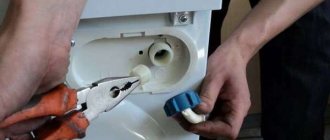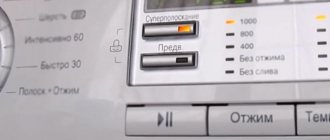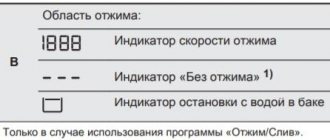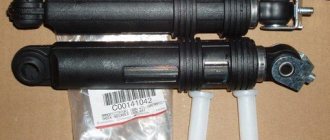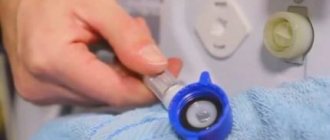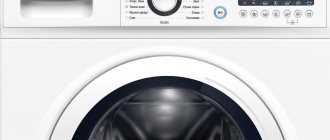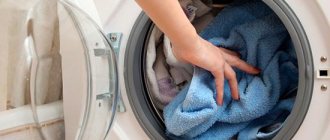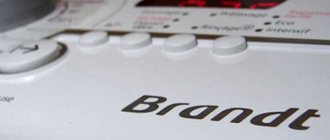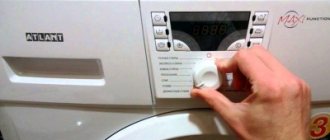What does the error indicate?
An explanation of all the errors that a Gorenje washing machine may produce can be found in the instructions for the equipment. Therefore, if you notice that the machine has stopped working, you should immediately look at the user manual. Fault code F4 informs about a breakdown of the tachometer or motor, or a break in the wiring between them. Very rarely, the problem may be in the main control module, or more precisely, in the failure of the triac responsible for the engine and tachogenerator. What can happen to an electric motor? Typically observed:
- wear of commutator brushes;
- lamella defect;
- problems with the stator or rotor winding;
- break in the power supply.
If we talk about the Hall sensor, then usually its contacts come off or the fastenings become loose. In any case, diagnostics of the Gorenje washing machine will be required. Let's figure out what to do first, how to perform diagnostics and repair the automatic machine yourself.
Features of the design and operation of Gorenje machines
The main feature of Gorenje automatic machines is their durability and reliability; if the rules of use are followed, this equipment will last more than fifteen years. The functionality is thought out to the smallest detail, and every consumer will find his own model.
Each device is equipped with basic functions:
- Normal Care. Designed for laundry that is worn every day and has an average degree of soiling.
- EcoCare. Designed specifically for loading small amounts of laundry, it saves water and electricity.
- TimeCare. Intensive wash for cotton fabrics and heavily soiled laundry.
- AllergyCare. This program is designed for people with special needs and children. If you have problems with allergies, this is what you need. Involves several stages of rinsing.
And there are a number of additional functions:
- Mix. Allows you to load laundry from fabrics of different structures. More details can be found in the instructions that came with the machine.
- StainExpert. Designed for washing items with stubborn stains, thanks to the ideal selection of temperature conditions and program duration.
- TotalWeightControl. There is a built-in sensor that can detect the weight of the load and select the ideal washing program.
- Gorenje Sensocare. Optimal combination of temperature and washing duration.
The latest technologies are used in production, for example, the heating element is treated with an additional protective nickel coating, which prevents the formation of scale. The engines operate almost silently, with energy consumption class A, A++. And, of course, we thought about the children, namely their safety, since there is a child lock.
The model range has a very wide range, which offers laundry loading from 4 to 8 kg, front and vertical loading, spin speed from 800 to 1500 rpm. There are also models with drying, which have been gaining popularity in recent years.
Operating rules
We can eliminate the misuse of the washing machine and thus avoid service costs. It is enough to adhere to the basic rules. Let's consider the most significant of them:
- When washing, use only high-quality detergents.
- Monitor the volume of things loaded into the drum, do not overload it.
- Use equipment only in rooms with low humidity.
- Monitor and prevent foreign objects from entering the drum during washing.
If any malfunction is detected, the unit reports an error, accompanied by an appropriate sound signal. Thus, the breakdown can be identified by the code and troubleshooting can begin in a timely manner.
Help from professional specialists
Most often, it is recommended to contact a professional so as not to aggravate the situation with independent actions. Violations of repair work will only increase financial costs. Only a specialist can accurately determine the cause of the failure, select an original analogue, and perform all repair work.
But it also happens that symptoms do not always indicate refusal. Quite often, the cause of the error signal is a violation committed during operation. For example, water leaks through a poorly closed hatch. And the machine vibrates due to the fact that it is simply installed incorrectly, or the loading of things into the drum is uneven. Before contacting the workshop, you must make sure that even if all conditions are met, the unit is not operating correctly. Having eliminated the probable causes caused by malfunctions, you can contact the workshop for help with repairs or advice.
Table of error codes for Gorenje washing machines.
Decoding the washing machine code
Possible malfunction of the washing machine
For machines with control system PG1 - PG5
Temperature sensor circuit malfunction (washing program ends early).
1. Open circuit or short circuit in the temperature sensor circuit - replace the defective parts.
Malfunction of the hatch door locking system (SMA does not start or works for several seconds, the filled water is drained).
1. Mechanical damage to the contacts of the blocker sensor - repair/replace the UBL of the washing machine.
2. Poor contact in the UBL limit sensor - check and service the contacts, replace the UBL.
3. The hatch door is not closed tightly - try closing the hatch again.
Malfunction of the water filling system (the required water level in the tank was not reached within the specified time). The washing program is interrupted.
1. Low pressure in the water supply system - take measures to eliminate the problem.
2. The water inlet valve is faulty - replace it.
3. Malfunction of the water level sensor - repair the hydraulic system or replace the pressure switch.
Tacho chain malfunction. The CM makes 1 attempt to restart the centrifuge. If it is impossible to start the drum, the system drains the water.
1. There is a break in the tachogenerator-electric motor section of the circuit - the TACH is out of order, the unit needs to be replaced.
Malfunction of the electric motor control system (the drum does not develop the required speed). The SMA makes 3 attempts to start the motor, after which the water is drained and an error code is displayed.
1. Malfunction on the inverter board - replace the inverter board of the washing machine.
How to notice a failure in time
When starting a wash, the user rarely follows the stages of the program - he threw in the laundry, added the powder, turned on the cycle and left. Usually everything happens this way, so it’s difficult to notice problems in time. The SM self-diagnosis system comes to help the user. The electronics “notice” the failure in time and notifies the owner of the washing machine by displaying error codes on the screen.
Let's look at the most common SM fault codes from the Gorenia brand:
- F1 (Ф1) indicates a short circuit of the heater or an open circuit in the power supply of the part.
- F2 (Ф2) lights up when there is no water intake into the system.
- F31 (Ф31) indicates a malfunction of the electric motor (EM) tachogenerator.
- F21 (F32) means loss of communication between the electronic board and the ED.
- F4 (Ф4) lights up when the water does not heat up.
- F41, F43 - errors confirming water overheating.
- F5 (F5) - water does not drain from the tank.
Read more about other alphanumeric combinations in a separate article dedicated to deciphering CMA codes from the Gorenje brand.
To confirm the error or eliminate a one-time system failure, you can reboot the system. But don't get carried away with this method if the code appears again.
- Turn off the power by removing the plug from the outlet.
- Leave the equipment idle for 15–25 minutes.
- Turn it on and run test mode.
If the code disappears, it may have appeared incorrectly. If it lights up again, then there is a problem. If there are no codes, but the operation of the equipment is disrupted, the manufacturer suggests conducting a simple service test at home.
How to run a service test and detect a failure
For the machine to enter testing mode, follow the following procedure:
- Turn the mode selector to the zero position.
- Press the two outer buttons together, holding them for a while.
- Turn the selector one notch in a clockwise direction.
- After 5 seconds, release the pressed keys.
The result of the operation should be the flashing and extinguishing of all lights on the user panel.
After the system has entered test mode, check the serviceability of the nodes one by one, according to the instructions.
UBL (electronic hatch lock):
- Open the hatch for 10 seconds.
- Close the door.
- If the operation is successful, all lamps on the panel will light up. If incorrect, code F2.
- The controller will measure the sensor resistance for 2 seconds.
- A successful test will end with the lamps going out. Otherwise, F2 will be displayed.
Water intake into the powder dispenser compartments:
- 5 seconds to test hot water.
- 10 seconds for pre-wash (soak).
- 10 seconds for main wash.
- Pre-cycle and main cycle until the tank is filled with water to the first level.
- Everything is fine - the lamps will flash. If defects are detected, F3 will light up on the display.
Drum - rotation and launch:
- The motor starts and spins in one direction for 15 seconds. After a 5-second pause, it rotates back, and the heater turns on for a while.
- Everything is fine - the indicator goes out. The failure will be indicated by code F4 or F5.
- The drum will rotate for half a minute in the range from 500 revolutions per minute to the maximum threshold (1200–1400 depending on the model).
- If the spin is ok, the light bulbs will remain as they were.
- The pump will start for 10 seconds. After performing a test drain, the machine will reduce the water level in the tank.
- If everything is good, all LEDs will light up. In case of breakdown - code F7.
Final spin with drain:
- The pump is turned on, the drum rotates as if spinning, in the range from 100 revolutions to maximum.
- The lights go out if everything is OK. If the speed does not reach the maximum level, the F8 code will light up.
The washing machine freezes during washing: the main reasons
Below are the most common reasons why the machine stops during the washing phase.
Problems with getting water - from 1300 rubles.
There are a number of problems that lead to the fact that the washing machine cannot fill with water. And if there is no water in the machine, then the washing does not start. In this case, the freeze occurs at the very beginning of the cycle.
The washing machine does not draw water and freezes at the beginning of the wash cycle.
How to fix
It is necessary to diagnose the washing machine and eliminate problems that prevent water from flowing.
Failure of the pressure switch (water level sensor) - from 1600 rubles.
Failure of the pressure switch - the sensor responsible for the amount of water in the machine - leads to the fact that the washing machine cannot determine how much water is in the machine and stops.
The washing machine does not fill with water or interrupts the program during the wash, rinse or spin cycle.
How to fix
The level sensor needs to be replaced.
Malfunction of the heating element (tubular electric heater) - from 1400 rubles.
If the heating element breaks down, the machine cannot heat the water. But it is desperately trying, and the electronic brain is “waiting” for the water to reach the desired temperature. As a result, the washing machine freezes - it has taken in water and is trying to heat it up.
The washing machine does not heat the water. An indirect sign of this breakdown is that even if you select a high temperature, the sunroof glass remains cold. It is possible that a heating error may appear on the screen in machines with a display.
How to fix
A failed heating element must be replaced.
Wear of washing machine motor brushes (for commutator motors) - from 1,400 rubles.
During operation, the brushes wear out and when their length is less than 1 cm, they stop contacting the engine commutator. Due to poor contact, sufficient torque is not created in the motor to rotate the rotor. Because of this, the washing machine drum first cannot accelerate during the spin cycle, and then stops rotating during the wash cycle.
The washing machine does not reach high spin speeds. When the carbons of the brushes stop contacting the commutator, the machine stops spinning the drum and washing. The washer motor may spark.
How to fix
The motor brushes need to be replaced.
If the wash does not start and the drum remains motionless, the problem may be that the drum is jammed. This can happen due to small foreign objects getting into the tank (during previous washes) or due to “misalignment” of the drum (fastenings have become loose or the bearing has failed). Whatever the reason, a jammed machine cannot turn the drum and it seems that the unit is frozen during the washing phase. You can check whether the problem is really a jammed drum by trying to turn it by hand, after turning off the machine. If the drum does not spin or spins with great difficulty, this is exactly your case.
The washing machine does not spin the drum and freezes.
How to fix
It is necessary to diagnose the exact cause of the drum jamming and eliminate it: removing the foreign object, adjusting the drum position or replacing the bearing
Problems with draining water - from 1000 rubles.
During each wash cycle, the machine changes the water several times. If there are problems with draining the water, most likely the process will stop and the machine will “freeze”, full of soapy water.
The washing machine did not drain the water and was stuck on the wash cycle with water in the tub.
How to fix
It is necessary to diagnose the washing machine and eliminate problems that prevent draining.
Malfunction of the control board - from 2000 rubles.
If the control board is damaged due to long-term use or power surges, various software failures occur. In particular, the machine may freeze during the washing phase.
The machine hangs while washing with water in the tank or is empty.
How to fix
The faulty board must be reflashed, repaired or replaced, depending on the extent of the damage.
Failure of the washing machine motor - from 2000 rubles.
Long-term use or exposure to water may cause the washing machine motor to burn out. In this case, the machine is deprived of its main rotating force, and the wash stops at the very beginning of the cycle.
How to fix
Engine repair or replacement is required.
However, quite often the machine copes with the washing stage “excellently”, but then some kind of malfunction occurs.
Weak sides
As a result of improper operation or installation, wear of parts and the use of unsuitable detergents, breakdowns of the washing unit occur. Let's get acquainted with the most obvious types of problems that disrupt the usual washing process of the Gorenye machine:
- Drain mechanism or pump. These elements quite often become unusable. You may notice how some characteristic features appear: water intake and drainage are poorly carried out, water stagnates in the tank. The reason is mainly clogging of hoses and other elements.
- Sometimes, when washing, you hear a knocking or noise, or feel strong vibration. In this case, it is most likely that the drum is clogged with foreign objects, or the bearings have become unusable. In both cases, it is necessary to deal with the problem as soon as possible.
- If you find that the machine begins to spin poorly, then the reason for this is most likely a problem with the belt. It holds the drum during the spin cycle, and most likely fell off. This problem is easily solved, but the repair procedure must be carried out by an experienced technician.
- If the unit refuses to turn on or display indications, the electronic module and timer programmer should be checked. Such malfunctions are typical due to mechanical wear or when water gets into the housing.
- If water gets into the engine, it will cause smoke and sparks, and may also cause a short circuit. If you observe such manifestations, then disconnect the device from the network and do not resume operation until a specialist arrives.
- If the water does not heat up properly, there is a problem with the heating element. This may be caused by scale buildup or a burnt out heater. The repair of this element should be treated with special attention.
Careless handling of the washing machine can lead to mechanical damage, which does not always affect its operation. However, if measures are not taken to eliminate them, they can worsen and cause a lot of trouble.
If a crack has formed in the glass of the hatch, the door handle is damaged, or the body is deformed due to a dent, you must invite a technician to fix the problem.
Error codes for Gorenje washing machines with control system PG1 - PG5
- Open circuit from the sensor to the electronics: ring and repair the wiring, check the contacts
- The sensor itself is faulty: testing with replacement of the broken sensor
- Problems in electronics: a burnt-out control controller will have to be replaced
There is a malfunction in the hatch locking device (UBL):
- First, we cut off the obvious reasons: close the door more tightly, make sure that no object is in the way
- The lock of the blocker is broken: in principle, you can repair it yourself
- Weak contacts in UBL: test, tighten
- Something else is broken in UBL
- Open circuit from the door closing sensor to the controller that controls the UBL: check the wiring and contacts
- Problems in electronics - call service
As a result, the wash is interrupted. What could have happened:
- Forgot to open the water supply tap or low pressure
- Error when connecting the drain hose
- A common cause is a broken fill valve or clogged filter.
- Failure of the pressure switch: diagnostics with replacement of the part or cleaning of the water inlet path is required
After another attempt to start the engine, the washing stops and the water is drained. Causes:
- Broken wiring in the TAXO circuit or loose contacts
- The washer securing the coil came off the tachogenerator, causing the sensor to jump out of its mounting socket
- The tachogenerator itself is faulty: it needs to be replaced
- The motor can also break down: it needs to be diagnosed and repaired or replaced.
After 3 unsuccessful attempts to restart the engine in normal mode, the electronics ends the wash program and drains the water. You need to check the following:
- Open circuit in the inverter: check the wires and contacts
- A break in the motor winding: either the winding or the entire motor will need to be replaced
- Something has broken in the electric motor, for example, the brushes could have worn out: it is better to call an experienced specialist for diagnosis and repair
- The SM inverter board has failed: diagnostics, repair or replacement of the board
If a problem is detected, the washing is paused, the electronics tries to start the engine again, and after failure, it completely ends the washing program and drains the water.
Ring and repair the triac circuit, replace it if it is not working. But, since all elements of the triac circuit, including itself, are located on the electronic controller, it is better to call a qualified specialist for diagnostics.
After 3 unsuccessful attempts to start the engine, the washing program ends and the SM drains the water. Possible reasons:
- Disturbances in the inventory circuit: ring the wiring of this section, strengthen the contacts, repair the wires
- Break in the motor winding: replacement of the winding or the entire motor
- The inventory itself is faulty: it will have to be replaced
- The CM inverter board burned out: board diagnostics, repair or replacement
Once this problem is detected, the wash stops:
- Thermal sensor is faulty: diagnostics and replacement
- Open circuit in the heating element control circuit: ring the circuit, tighten the contacts and repair the wiring
- The heater is burnt out: it will have to be replaced
- The control controller is faulty: it is better to contact a workshop to check and repair it
Possible causes and solutions
No flow or low pressure from the water supply
When you open the taps of the water supply system, water does not flow or flows weakly
Turn off the machine and wait for the problems in the plumbing system to be resolved
Clogged inlet hose or inlet strainer
Disconnect the supply hose and filter, inspect them and blow them out
Clean the hose and filter from debris and rinse under running water.
The side door is not closed tightly, the lock does not work
Check the tightness of the door, the condition of the locking mechanism and the fastening of the door hinges
Press the door firmly until the lock clicks. If necessary, clean the latching mechanism and tighten the hinges
Damage to connecting wires or their insulation, oxidation of contacts
Inspect and test the internal electrical wiring with a tester for open circuits and short circuits.
Restore the integrity of electrical wires and their insulation, clean contacts
The inlet (fill) valve does not work
Check the operation of the valve when 220V is applied to it. Inspect and test the valve windings, electrical wires and contacts with a tester
Restore the connecting wires, clean the contacts. Replace the faulty valve.
The electric door lock is faulty
Test the blocker winding with a tester for open circuit and short circuit. Check the status of contacts
Clean contacts. Replace the faulty lock.
The level sensor (pressure switch) is faulty
Check if the sensor receiving tube is clogged.
Test the sensor and connecting wires with a tester for opens and short circuits.
Clear the sensor receiving tube of any accumulated debris.
Replace faulty sensor.
The software control module is faulty
The module does not receive control signals to trigger the machine components when they are working properly
Use a tester to check the receipt of control signals to individual nodes. Repair the module in a workshop or replace it with a working one.
Most of these problems can be fixed on your own, but in some cases you cannot do without contacting a service workshop.
If you decide to carry out the repairs yourself, we offer the best range of spare parts for washing machines.
Flashing indicators indicate error code
You should immediately understand that blinking buttons on the washing machine in any case indicate abnormal operation of the unit. However, this is not always a reason to contact a service center: blinking LEDs may simply be a consequence of your carelessness. For example, you forgot to turn on the water.
Therefore, first, determine what the error code means and try to fix the problem yourself. You can find out what error code means a combination of burning or flashing indicators on your washing machine from the instructions or by referring to the “Washing machine errors” section.
What is most vulnerable?
Unique Gorenje cars come in a variety of shapes and modifications. Units even with a water tank are produced under this brand! But despite the technology, the technology also has weaknesses. Based on statistical data obtained from service centers, we can identify the most common problems with the ASM of this brand:
- A quarter of calls to service technicians are related to a broken drain pump.
- Next comes the heating element. Either it is not made well enough, or it cannot withstand voltage surges, or it is affected by low-quality water, but heater burnout is the scourge of all automatic washing machines, not only the Gorenye brand.
- “Bronze” goes to the drain pipe - leaks, drying out, blockages, all this blocks the normal operation of the drain system.
- Another problem with any machine equipped with a commutator EM is the brushes.
- Another problem specific to these automatic machines is a broken handle on the door. We will not delve into the solution to this problem, because disassembling the door, buying a new handle for the Gorenje machine and replacing it with your own hands is not difficult even for an inexperienced user. Example of work:
We will devote the next part of the review to instructions for eliminating the listed faults.
Troubleshooting algorithm
In order to fix a similar breakdown in a Gorenje washing machine, you will need to check the following:
- First, check for the most common reason, whether the liquid supply valve is open; you could simply not open it completely and this will also lead to similar consequences.
- Next, assess whether the pressure in the main is sufficient; if this is not the case, contact the water utility for clarification. If there is frequent insufficient pressure, you can install a pump that will artificially create the required pressure. If you do not want to incur additional costs, run the wash during the period when the pressure level is highest.
- Check the filter, it is located on the inlet hose; unscrew the knot and rinse the mesh.
- Then inspect the hose for damage or wear. To do this, disconnect the device from the power supply and disconnect it. If it is torn, you can buy a new one; to avoid installation problems, buy original spare parts from authorized dealers.
- Next, check that the hose is connected correctly. The instructions for the device indicate that its lower element should be at a distance of forty centimeters from the floor surface.
- It is also worth checking to see if there is a leak from the tank, since if there is a fistula, the liquid level will invariably drop.
- Check to see if the detergent opening is clogged. If you find a blockage, remove it; if a large amount of plaque has accumulated, remove it. Stores sell special products for softening and dissolving plaque; just soak the container for a couple of hours and the problem is solved.
- Inspect how tight the connection of all elements is near the powder receptacle.
- The pressure sensor could also cause the breakdown. Disconnect and test it; to do this, remove the MCA cover and find a device that looks like a disk with a tube connected to it (blow and rinse, since clogging it could also lead to error e3). What to do if the sensor is faulty? Cannot be repaired, needs replacement.
- The wiring is broken. Call the chains involved in this process. Strip and solder the gaps, crimp the connecting terminals.
- Control block. Failure of this element is perhaps the most expensive and time-consuming problem. To fix it, you will have to contact a service center for help. Repair options can be different - flashing, replacing a faulty microcircuit or the entire unit.
There is no water or it does not pass
Despite the impressive list of possible malfunctions, do not panic and call a specialist. Almost everything can be fixed with your own hands within a few minutes. First, we check the presence of water in the water supply - often shutdowns occur without warning the residents. The second step is to inspect the tee tap or water socket to make sure that the water supply to the machine is not obstructed.
Next, we pay attention to the mesh filter, which is located on the inlet valve and often becomes clogged. Blockages are removed as follows:
- turn off the machine from the power supply and turn off the water;
- unscrew the inlet hose and disconnect it from the body by loosening the clamps;
- We clamp the filter with pliers or pliers and pull it towards ourselves;
- We clean the mesh with tweezers, and finally rinse it under strong water pressure. If there is heavy scale, it is better to carry out intensive cleaning: soak the product in a solution of warm water and citric acid for 30-60 minutes;
- return the filter and hose to their place.
All that remains is to check whether the situation has been corrected - run an express wash on the washing machine. To prevent new blockages, it is necessary to regularly clean the mesh and install an intermediate filter. Remember that even clean tap water contains various impurities that settle on the machine parts. If cleaning does not help, we continue the repair and deal with other possible faults.
What causes the heating element to fail?
Most often due to low-quality powder or hard water. There are other reasons:
- Short circuit.
- The appearance of a large amount of scale.
- Operational wear (after 6-8 years of operation).
- Washing too frequently (3 times a day or more).
In order for the heating element to work longer, our service center does not recommend using cleaning products based on household chemicals. There is an old and proven method - cleaning with citric acid. To do this, run the wash without laundry at 90 degrees, pour citric acid directly into the drum. And let the drum spin and the heating element be cleaned.
To understand whether the heating element works or not, just look at it. There will probably be burn marks or centimeter scale on it.
Installing a new heating element does not take much time, but it is better to entrust this work to a specialist.
Failure of heating element – from 1800 rubles*
The heating element is responsible for heating the water. Due to impurities in the water, powder particles and small debris from clothes, over time the heating element becomes “overgrown” with scale, which leads to a decrease in its performance. In an effort to heat the water to a given value, the heating element works in an enhanced mode, which leads to its burnout. Either the heating coil fails, or the housing itself burns out.
SIGNS
The Gorenje washing machine does not heat the water. Modern models can interrupt the wash cycle after an unsuccessful heating attempt, while others (older) wash in cold water. If the housing burns out and a breakdown occurs, the machine will knock out the machine or RCD.
The display may show error codes F6 or F4.
HOW TO FIX
The heating element must be replaced with a new one.
*Rates are only for the work of the master, a new heating element is paid separately.
Test programs and error codes for Gorenie WA-101/121/132/162/162P washing machines
Modern washing machines “Gorenje WA-101/121/132/162/162P” (Prologic and Pinifarina lines) have a developed internal self-diagnosis system, which allows not only to check the correctness of the washing phases (test program 1), but also to diagnose errors that have appeared during operation of the washing machine. The corresponding error code is displayed on the front panel indicator (test program 2). Below we will consider the procedure for launching and executing test programs for washing machines, as well as deciphering error codes.
Test program 1
This program allows you to control the execution of the basic operating modes of the machine. It does not indicate the presence of malfunctions, but allows you to quickly visually check the operation of the device. The duration of its execution is about 2 minutes.
Test program 1 is started as follows:
In all cases, the program is executed only if the program selection knob is in a position other than “0”.
During the execution of test program 1, operations are performed in the following sequence:
Using the connecting cable, connect the washing machine...
- Image
- Text
196363
• Using the connecting cable, connect
washing machine to the mains.
• Prescribed voltage and other data are indicated
on the data plate, which is located above the loading hatch of the device.
The wall socket must be appropriate
properly grounded, access to it must be unobstructed.
Electrical wiring grounding and connection
The installation of machines to the electrical network must be carried out by a qualified specialist in accordance with current standards and regulations.
A faulty connection cable may
Replace only by the manufacturer or an authorized specialist.
The device cannot be plugged into a power outlet
designed for a razor or hair dryer.
Electrical connection
Electrical connection
8
Troubleshooting algorithm
In order to fix a similar breakdown in a Gorenje washing machine, you will need to check the following:
- First, check for the most common reason, whether the liquid supply valve is open; you could simply not open it completely and this will also lead to similar consequences.
- Next, assess whether the pressure in the main is sufficient; if this is not the case, contact the water utility for clarification. If there is frequent insufficient pressure, you can install a pump that will artificially create the required pressure. If you do not want to incur additional costs, run the wash during the period when the pressure level is highest.
- Check the filter, it is located on the inlet hose; unscrew the knot and rinse the mesh.
- Then inspect the hose for damage or wear. To do this, disconnect the device from the power supply and disconnect it. If it is torn, you can buy a new one; to avoid installation problems, buy original spare parts from authorized dealers.
- Next, check that the hose is connected correctly. The instructions for the device indicate that its lower element should be at a distance of forty centimeters from the floor surface.
- It is also worth checking to see if there is a leak from the tank, since if there is a fistula, the liquid level will invariably drop.
- Check to see if the detergent opening is clogged. If you find a blockage, remove it; if a large amount of plaque has accumulated, remove it. Stores sell special products for softening and dissolving plaque; just soak the container for a couple of hours and the problem is solved.
- Inspect how tight the connection of all elements is near the powder receptacle.
- The pressure sensor could also cause the breakdown. Disconnect and test it; to do this, remove the MCA cover and find a device that looks like a disk with a tube connected to it (blow and rinse, since clogging it could also lead to error e3). What to do if the sensor is faulty? Cannot be repaired, needs replacement.
- The wiring is broken. Call the chains involved in this process. Strip and solder the gaps, crimp the connecting terminals.
- Control block. Failure of this element is perhaps the most expensive and time-consuming problem. To fix it, you will have to contact a service center for help. Repair options can be different - flashing, replacing a faulty microcircuit or the entire unit.
Let's check the pressure switch tube
If everything in the drain system is clean and in good order, then it is worth checking the pressure switch. It is the level sensor that transmits information about the degree of filling of the tank to the control board, starting to collect or drain water. When the tube becomes clogged or loses contact with the module, the readings are displayed incorrectly and the system displays error F7. You can confirm or refute your guess by following the instructions.
- Disconnect the washing machine from the power supply and water supply.
- We unscrew the bolts holding the top cover of the machine and move the panel forward.
- We are looking for a pressure switch - a round plastic box in black or white.
- We unscrew the bolts and disconnect the wiring, removing the sensor with the tube from the housing.
- We inspect the box and tube for damage or blockages.
The key point is to check the pressure switch for functionality. You will need a tube with a diameter equal to the sensor fitting, which should be inserted into the pressure hose. Next, all that remains is to blow lightly into the hole. If the contacts are closed and the device is working, you will hear 2-3 characteristic clicks. Otherwise, the situation can only be corrected by completely replacing the device.
If everything is in order with the pump, debris filter, hoses and level sensor, then the problem is with the control board. It is useless to figure out how and what to do here - it is almost impossible to cope with electronics on your own. It is better to immediately contact professional repairmen.
Share your opinion - leave a comment
Drain pump: checking and replacing the pump in the Gorenje machine
The drain pumps in the Gorenje washing machine actually break down too often and wear out faster than other components.
Machines of this brand are characterized by increased sensitivity to water, which contains many different impurities. The moving elements are located almost side by side, so water stone settling on them interferes with operation. Parts wear out faster and eventually the pump fails and requires replacement.
Replacement or self-repair of the drain pump proceeds as follows:
- Disconnect the device from the power supply.
- Remove the detergent dispenser. Pour out the remaining water from it and put it back in place.
- Place the washing machine in a comfortable position.
- It is easier to access the pump from the bottom, so it is better to place the machine on its side.
- SM brand Gorenye is closed with lids on all sides, and the bottom is no exception. Therefore, you will have to unscrew several screws to gain access to the “insides” of the machine from the bottom.
- Now you need to inspect the pump, checking its serviceability. You will need a tester to measure the resistance. Disconnect the wiring and start measuring. If the tester screen shows about 160 ohms, then the pump is ok. If there are no indicators, then the pump is broken.
- Remove the pump by unscrewing the fasteners.
- Buy a new original part and install it in place of the old pump, reconnecting all the wiring.
- Attach the cover from the bottom, restore the vertical position of the machine and run a single wash in test mode.
If you are interested in how to clean the pump filter for a Gorenje washing machine, watch the video:
Let's check the filter
Diagnostics begins with the simplest thing - cleaning the garbage filter. This is a plastic spiral on which dirt and other debris that gets into the machine settle. The element is located in the lower right corner of the Gorenye washing machine behind a round or square technical hatch. Before checking the plastic and cleaning it, it must be removed.
- Disconnect the machine from the power supply and water supply.
- Use a knife or screwdriver to pry up the hatch and, releasing the latches, open it.
- Lay a rag nearby or place a container to collect water.
- Holding the tab on the filter, unscrew the filter clockwise.
Now let's move on to the actual repairs. We rinse the filter under running warm water, after removing debris and deposits from the spiral. If the layer of dirt is too thick, you can soak it in a solution with citric acid for 20-40 minutes.
You shouldn’t limit yourself to just cleaning the garbage filter. At the same time, it is better to immediately check the pump, volute and drain pipes for blockages. We take a flashlight and shine through each element, and if we find foreign objects, we pull it out with tongs or pliers
We pay special attention to the pump impeller, on which hair often gets wrapped up, causing breakdown and error F7
Reasons for this code
When error E3 comes on, it indicates that there is not enough water in the washing machine to complete the selected program. First, the machine tries for a long time to fill the shortage, and then stops the system. A number of malfunctions of the Gorenje washing machine lead to this situation.
Problems with water intake. Low pressure in the water supply, a closed tap, a clogged inlet hose, filter grid or water inlet pipe. This also includes other obstacles to the flow of liquid into the drum - bending, squeezing of hoses or their disconnection from the supply pipe. Problems with the drainage system. If you connect to the drain incorrectly, then all the water entering the machine will immediately drain into the sewer, and the level required to start washing will never be reached. In this case, the set takes a long time and with the characteristic sound of liquid draining. The amount of water lost can exceed several hundred liters, and if the apartment does not have a water meter installed, it will not be easy to notice the problem.
Leak. Everything is clear here - as soon as the system detects a leak, the cycle ends
The easiest way to determine it is if you pay attention to the floor near the washing machine. Failed pressure switch. This is a water level sensor, and if it does not work correctly, data on the amount of water does not flow to the control module
The machine does not know how much liquid is in the tank and whether it is enough to start the cycle, so it does not give a signal to start washing. Control board failure. The situation is the opposite of the previous one. The module cannot receive information about the amount of water, so it blocks the dial to avoid leaks and short circuits.
Most of the listed breakdowns can manifest themselves at any stage of washing, but more often error E3 appears at the very beginning. There is also a characteristic sign of approaching trouble - a long period of water filling, which is why the machine washes longer than usual. To accurately diagnose the source of the problem, you will need to check each possible cause one by one.
The pressure switch pipe is clogged
If the drainage is clean and the pump is working properly, then the cause of the failure may be the pressure switch. This is a level sensor that sends data to the board about the degree of filling of the tank. If the device does not work correctly, the module does not receive the necessary information and does not give a command to drain. The system stops and displays error E7. To check the serviceability of the pressure switch, you must:
- disconnect Gorenje from communications;
- remove the top cover;
- near the right wall, find a pressure switch - a black or white plastic “box”;
- loosen the screws holding the sensor;
- remove the “box” along with the connected hose;
- Inspect the device for damage and blockages.
A visual check is not enough. It is recommended to find a tube commensurate with the sensor fitting, place it against the pressure switch hose and blow lightly into the hole. A working device will “respond” with 2-3 clicks due to closed contacts, and a broken one will ignore the air flow. In the second case, replacement is necessary.
If the drainage, pump and pressure switch are working properly, then there is only one option left - a failure in the control board. It is strongly not recommended to diagnose the module at home. It’s better not to take risks and entrust the inspection and repair of electronics to professionals.
Basic faults
It is already difficult for a modern person to imagine his life without such an indispensable assistant in everyday life as a washing machine. While the equipment is working properly, we don’t even notice the convenience and comfort, and only when something bad happens to it, and we have to re-learn the forgotten skills of hand washing, the contrast between how it was and how it is is felt especially sharply. Let's try to figure out what the most common breakdowns of washing machines are, and also look at some ways everyone can fix them on their own.
The machine won't turn on at all
During washing the plugs are knocked out
The water does not heat up, the water does not flow into the machine at all, the water is drained at the beginning of the wash The washing machine is noisy, knocking or makes “unusual” sounds
Often this problem occurs when washing curtains that do not absorb water, but create foam. Too much of it is formed, and it leaks out through the technological holes in the system. The drum does not rotate
What is self-diagnosis of equipment?
Any modern technology in one form or another is capable of checking itself for problems. Electronics make it easy to monitor breaks, short circuits and deviations in nominal values in significant components. Depending on the size and information capabilities, this may be a simple light indication, there may be a full text description, or there may be a system of codes. Each manufacturer tries to maintain its own unique system, which may vary between different models or model ranges. Same with washing machines.
Procedure for replacing the drum axle bearing on Gorenje washing machines
All modern washing machines are built on the principle that a drum rotates inside the tank. In such a system, the main load-bearing element is a bearing, which is mounted on the axis of the drum. Statistics show that the proportion of SM malfunctions associated with defects of this element is quite high.
The cause of bearing damage is most often wear of the seal, which causes water to penetrate into the bearing and cause rapid corrosion.
If bearing defects occur, it must be replaced, as it cannot be restored. The bearing is always replaced along with the oil seal, regardless of the condition of the removed oil seal. When installing a new oil seal, its groove must be filled with a specialized lubricant; in extreme cases, litol-24 can be used. Replacing a bearing with an oil seal is one of the most complex and important operations performed when repairing a motor vehicle.
Bearing defects can manifest themselves in the form of increased noise, as well as knocking when the drum rotates (especially during spinning), up to a visible beating. Let's consider the procedure for replacing the drum axle bearing in the SM “Gorenje WA 101/121/132/162(P)/982/-1182/1384”.
When replacing a bearing, perform the following operations:
- remove the back cover of the SM;
- remove the belt from the drum pulley;
- unscrew the screw securing the pulley, remove the pulley, and then the bushing;
- unscrew the three nuts in the center of the cross support (Fig. 1);
Rice. 1.
knock the drum axis out of the cross support. To do this, apply a wooden block to it and lightly hit it with a hammer and recess the axle by 20 mm (Fig. 2);
Rice. 2
using two ring wrenches, unscrew the three nuts at the edges of the support (Fig. 3.) and remove the screws on which they were screwed;
remove the cross support (Fig. 4.);
Rice. 4
Using a flat screwdriver, remove the oil seal (Fig. 5.)
Rice. 5
At the same time, pay attention not to damage the plastic ring underneath (Fig. 6);
Rice. 6
use a hammer or puller to remove the bearing (Fig. 7.);
Rice. 7
press in a new bearing, using the support of the old one as a mandrel (Fig. 8);
Rice. 8
clean the surface of the Simmer ring from contaminants (Fig. 9);
• install in reverse order: cross support, pulley, belt, back cover CM.
When installing the cross support, it should be noted that the screws located at its edges are screwed first, and then in the center.
The article was prepared based on materials from the magazine “Repair and Service”
All the best, write to Elremont 2006
Pump problems
Pumps most often fail, most likely not due to manufacturing defects, but due to unfavorable operating conditions. The water in domestic water supply systems is far from the European quality standards for which imported household appliances are created. Impurities of salts and heavy metals slowly but surely cause barely reversible damage to many SMA systems. And the compactness of the body, due to which all the parts are located close to each other, completes the bad job: the parts wear out ahead of time. As a result, the pump requires replacement.
Have you decided to carry out the repairs yourself to save on the services of a professional? You will need a clear work plan:
- Disconnect the device from all communications - power supply, water supply and sewerage.
- Remove the powder cuvette, drain the water and replace it.
- Move the equipment so that there is more free space around it.
- Tilt the body to one side, because you will have to get to the pump through the bottom.
- While cars of other brands have an open bottom, in our case the bottom is tightly screwed with a lid. It is easy to dismantle by unscrewing several fasteners.
- There is a pump under the cover - next to it there is a large black drain pipe, so it is impossible to confuse the pump with another unit.
- It’s easy to check the functionality of an element: you will need a tester. Disconnect the wires from the pump, switch the device to resistance measurement mode and measure the readings. If they are around 160 ohms or more, the pump is working. If nothing lights up on the screen, the pump is broken.
- Remove the part by unscrewing the bolts holding it.
- Take the old part to the store to purchase a similar one.
- Install the unit in place of the old one, connect the wiring.
- Screw the bottom.
Testing the tachometer
Before you start repairs, you need to figure out where the tachometer is located in Gorenje washing machines. The tachogenerator controls engine speed and is installed directly on the engine rotor. What should I do to get to the Hall sensor? The algorithm will be as follows:
- turn off the power to the washing machine;
- disconnect the unit from the water supply and sewerage;
- Unscrew the bolts securing the rear wall of the case, remove it and set it aside;
- Carefully remove the drive belt. This is quite simple to do - start pulling it towards you, at the same time, with your free hand, rotating the pulley;
- disconnect the power cable from the electric motor. Before removing the wires, take a photo of the connection diagram or mark them, this will allow you to avoid getting confused with the connection during reassembly;
- Unscrew the screws holding the motor;
- start shaking the engine back and forth, this will allow you to remove the element from the housing.
Access to the tachogenerator has been obtained; it can be carefully inspected. Due to strong vibrations of the machine during operation, the contacts could come loose or the sensor fastenings could loosen. Error 4 can be eliminated by simply tightening the fastening or restoring the damaged chain. If no defects are detected during external inspection, you should check the resistance of the Hall sensor.
For further diagnostics you will need a multimeter. Firstly, you can select the resistance determination mode on the device. Apply the tester probes to the tachogenerator contacts. If the multimeter screen displays a value of about 60-70 Ohms, then the Hall sensor is working.
Secondly, you can switch the tester to voltage measurement mode. During this test, it will be determined whether the sensor produces current or not. For diagnostics, the probes of the device are applied to the contacts of the tachogenerator, while the engine is rotated with the other hand. If the values on the multimeter screen change (within 0.2 V), then the sensor is working.
The heating element has burned out
Heater failures are typical for any car - from budget Ariston and Indesit to premium SMA Miele or AEG. The Gorenje brand is no exception. But the reasons for the combustion of the element do not lie in the brand, but lie on the surface:
- Plaque from impurities in tap water settles on the tubular element, leading to overheating and burnout of the unit.
- Frequent interruptions of the wash cycle and system reboots.
- Constant high temperature washes.
- Power surges.
If the water stops heating, you need to check the heating element and, if necessary, replace it with a new one. Before work, prepare the equipment - disconnect it from communications and place it in a place convenient for repairs, turning the back side towards you. You will see a service hatch - remove its cover by unscrewing the screws.
The heating element is already visible, but it is inconvenient to get to it - the drive belt is in the way. Dismantle it by removing the strap from the pulley.
Now the work is carried out according to the following scheme:
- Remove the wires from the heater contacts.
- Take a photo or mark the wiring so you don't make a mistake when reassembling it.
- Use a tester to measure the resistance, setting the minimum values on the device. The probes should touch the two outermost contacts. The working element will show numbers in the range of 10–30 ohms. A faulty heating element will display one on the ohmmeter display.
On a note! If the test shows that the heater is working properly, check the wiring and temperature sensor.
Now remove the knot:
- Unscrew the large nut from the bolt that holds the TEN in the hole.
- Push the fastener inward and forcefully (but gently) pull the part, loosening it to the sides. Doesn't work? Use WD-40 or its equivalent.
- Having taken out the assembly, remove the debris (scale) from the mounting hole with your hands.
- It's time to install a new spare part - install it in the groove, making sure it fits tightly.
- Tighten the fastener.
- Replace the wiring and drive belt.
- Close the service hatch and screw in the screws.
- Run test mode with water heating.
